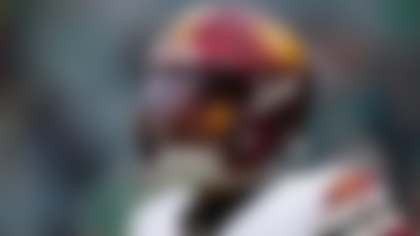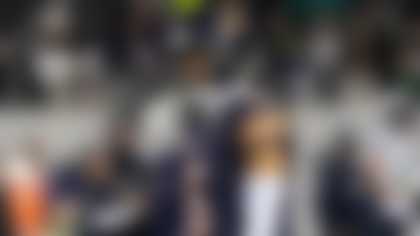NEW YORK -- Escaping from the early rounds clearly will be remembered as the strategy of choice in the 2009 NFL Draft.
The trend created considerable buzz throughout the league by confirming the widely held opinion among NFL talent-evaluators that this year's college crop was seriously lacking in elite talent, the kind worthy of selection in the first round and on Day 1 as a whole.
"The worry that a lot of teams had," an NFL coach said Sunday, "was that you probably had a better chance of getting (colossal upper-tier busts such as) Ryan Leaf or Rick Mirer this year than Peyton or Eli Manning."
Multiple teams -- most notably the New England Patriots, Cleveland Browns, Dallas Cowboys, San Francisco 49ers, and Seattle Seahawks -- decided they were better off piling up late-round choices and even 2010 picks rather than execute all of their picks within the first two rounds this year.
For the most part, the consensus among general managers around the league was that far better values could be found in the latter portion of the draft.
And, as one GM pointed out, "the economy is no small consideration in all this. Those second-day players are a lot less expensive, but you can still find some who will contribute."
The Patriots certainly have a strong history of late-round success. They found a couple of pretty good quarterbacks in sixth-rounder Tom Brady and seventh-rounder Matt Cassel, now with the Kansas City Chiefs.
Pats coach Bill Belichick is generally regarded as one of the greatest judges of talent in the history of the game. On the premise that his moves offer a fairly strong barometer of a draft's quality, it's fair to say that the two downward trades he made on Saturday and two others he swung on Sunday made a strong statement. The Patriots wound up with extra late picks, and two second-round choices in 2010, which is considered to have a much stronger draft class than this year.
On Sunday, they also sent cornerback Ellis Hobbs to the Philadelphia Eagles for a pair of fifth-round picks this year.
"We started off (Saturday) with six picks in the first three rounds and we ended with eight picks in the first three rounds, and felt like that was a good area to be in this draft from a depth standpoint and the quality of players we were getting with those picks," Belichick told reporters in Foxborough, Mass.
The Pats used the first of four second-round picks, No. 34 overall, to address a key need by taking Oregon safety Patrick Chung, who is expected to replace Rodney Harrison. At No. 40, they selected a nose tackle, Boston College's Ron Brace, who gives them depth and perhaps an insurance policy if things ultimately don't go well in contract-extension talks with current nose man Vince Wilfork. They hit need again at No. 41 with University of Connecticut cornerback Darius Butler, who was seen by some prognosticators as a possible late first-rounder. The Patriots' final first-day choice, No. 58, was a head-scratcher: Houston offensive tackle Sebastian Vollmer, who wasn't invited to the NFL Scouting Combine, but who, at 6-foot-8 and 315 pounds, certainly has enough size to make an impact.
Now, in order to move down, another club has to agree to move up and part with whatever is necessary to consummate such a deal. Does that make those teams less intelligent or savvied than the ones that moved down?
It all depends on your point of view.
Based on a strong sampling of league talent evaluators, anyone who truly believed that the first round offered an abundance of legitimate elite talent was in the minority.
But it also should be pointed out that a few of the teams that moved up did so with a certain level of desperation to fill gaping holes ... and give in to the pressures of disgruntled fans needing more incentive to fill seats.
One was the New York Jets, who did not have an obvious franchise quarterback. They felt the best way to get one was to ship a second-round choice and three players to the Cleveland Browns to climb to No. 5, where they selected former USC quarterback Mark Sanchez. They expect Sanchez to help them win games, but equally important is the expectation that he can help with the uphill challenge selling personal seat licenses in their new stadium, which opens in 2010. The Browns, led by former Belichick assistant Eric Mangini, would trade down twice more in the first round.
Freeman: 'I'd take me over them'
Soon after being the 17th overall pick in the 2009 draft, Josh Freeman was confident and said that he felt that he was the best quarterback selected in the first round. **More ...**
The Tampa Bay Buccaneers were another club looking for a franchise quarterback. Although they signed Byron Leftwich as a free agent to join a mediocre bunch at the position, they wanted to be sure they added another quarterback they targeted in this draft. Therefore, they swung a trade with the Browns to move up two spots and select Josh Freeman. The Kansas State product told PewterReport.com that he felt he was a "better quarterback" than the two other juniors chosen well ahead of him -- Sanchez and Georgia's Matthew Stafford, whom the Detroit Lions made the top overall pick.
With their switch from a 4-3 to a 3-4 defense, the Green Bay Packers have to find players who fit the new alignment. They used the ninth overall pick on an anchor nose tackle, B.J. Raji of Boston College. Then, for only the second time in 15 draft-day trades as Packers general manager, Ted Thompson decided to move up, getting a second first-round pick (No. 26, from New England, in exchange for a second-rounder and a pair of thirds), which they used on former USC linebacker Clay Matthews. It certainly was more dramatic than climbing into the fourth round last year for defensive end Jeremy Thompson.
"We were really zeroed in on Clay," Ted Thompson told reporters in Green Bay. "We think he's a really, really nice fit for our defense."
Nevertheless, Belichick best summed up the philosophy clearly shared by other NFL decision-makers when he rhetorically asked reporters, "Who would I be trading up for?"



